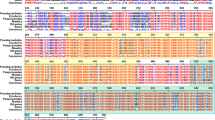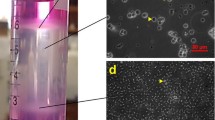Abstract
Establishing a cell line from endemic species facilitates the cell biological research of these species in the laboratory. In this study, an epithelium-like cell line RME1 was established from the blastula-stage embryos of the critically endangered cyprinid Honmoroko Gnathopogon caerulescens, which is endemic to ancient Lake Biwa in Japan. To the best of our knowledge, this is the first embryonic cell line from an endangered fish species. This cell line is well adapted to grow at 28°C in the culture medium, which was successfully used for establishing testicular and ovarian cell lines of G. caerulescens, and has displayed stable growth over 60 passages since its initiation in June 2011. Although RME1 did not express the genes detected in blastula-stage embryos, such as oct4, sox2, nanog, and klf4, it showed a high euploidy rate (2n = 50; 67.2%) with normal diploid karyotype morphology, suggesting that RME1 retains the genomic organization of G. caerulescens and can prove to be a useful tool to investigate the unique properties of endangered endemic fishes at cellular level.




Similar content being viewed by others
References
Bols N, Lee L (1991) Technology and uses of cell cultures from the tissues and organs of bony fish. Cytotechnology 6:163–187
Burgess S, Reim G, Chen W, Hopkins N, Brand M (2002) The zebrafish spiel-ohne-grenzen (spg) gene encodes the POU domain protein Pou2 related to mammalian Oct4 and is essential for formation of the midbrain and hindbrain, and for pre-gastrula morphogenesis. Development 129:905–916
Ciba P, Schicktanz S, Anders E, Siegl E, Stielow A, Klink E, Kruse C (2008) Long-term culture of a cell population from Siberian sturgeon (Acipenser baerii) head kidney. Fish Physiol Biochem 34:367–372
Collodi P, Kame Y, Ernst T, Miranda C, Buhler D, Barnes D (1992) Culture of cells from zebrafish (Brachydanio rerio) embryo and adult tissues. Cell Biol Toxicol 8:43–61
Dash C, Routray P, Tripathy S, Verma D, Guru B, Meher P, Nandi S, Eknath A (2010) Derivation and characterization of embryonic stem-like cells of Indian major carp Catla catla. J Fish Biol 77:1096–1113
Fryer JL, Lannan C (1994) Three decades of fish cell culture: a current listing of cell lines derived from fishes. J Tissue Cult Method 16:87–94
Higaki S, Koyama Y, Shimada M, Ono Y, Tooyama I, Fujioka Y, Sakai N, Ikeuchi T, Takada T (2013a) Response to fish specific reproductive hormones and endocrine disrupting chemicals of a Sertoli cell line expressing endogenous receptors from an endemic cyprinid Gnathopogon caerulescens. Gen Comp Endocr 191:65–73
Higaki S, Koyama Y, Shirai E, Yokota T, Fujioka Y, Sakai N, Takada T (2013b) Establishment of testicular and ovarian cell lines from Honmoroko (Gnathopogon caerulescens). Fish Physiol Biochem 39:701–711
Hightower EL, Renfro LJ (1988) Recent applications of fish cell culture to biomedical research. J Exp Zool 248:290–302
Hong Y, Winkler C, Schartl M (1996) Pluripotency and differentiation of embryonic stem cell lines from the medakafish (Oryzias latipes). Mech Dev 60:33–44
Lakra W, Bhonde RR, Sivakumar N, Ayyappan S (2006) A new fibroblast like cell line from the fry of golden mahseer Tor putitora (Ham). Aquaculture 253:238–243
Lakra W, Swaminathan TR, Joy K (2011) Development, characterization, conservation and storage of fish cell lines: a review. Fish Physiol Biochem 37:1–20
Loi P, Modlinski AJ, Ptak G (2011) Interspecies somatic cell nuclear transfer: a salvage tool seeking first aid. Theriogenology 76:217–228
Ministry of the Environment, Japan (2014) Red list of Japanese brackish and freshwater fishes. http://www.env.go.jp/press/file_view.php?serial=21437&hou_id=16264. Accessed 28 Aug 2014
Nakamura M (1949) The life history of a cyprinid fish, Gnathopogon elongatus caerulescens (Sauvage) in Lake Biwa. Nippon Suisan Gakk 15:88–96
Okuda Y, Yoda H, Uchikawa M, Furutani-Seki M, Takeda H, Kondoh H, Kamachi Y (2006) Comparative genomic and expression analysis of group B1 sox genes in zebrafish indicates their diversification during vertebrate evolution. Dev Dyn 235:811–825
Onichtchouk D, Geier F, Polok B, Messerschmidt MD, Mössner R, Wendik B, Song S, Taylor V, Timmer J, Driever W (2010) Zebrafish Pou5f1-dependent transcriptional networks in temporal control of early development. Mol Syst Biol 6:354
Parameswaran V, Shukla R, Bhonde R, Hameed AS (2007) Development of a pluripotent ES-like cell line from Asian sea bass (Lates calcarifer)—an oviparous stem cell line mimicking viviparous ES cells. Mar Biotechnol 9:766–775
Ristow SS, de Avila J (1994) Susceptibility of four new salmonid cell lines to infectious hematopoietic necrosis virus. J Aquat Anim Health 6:260–265
Ristow SS, Grabowski LD, Ostberg C, Robison B, Thorgaard GH (1998) Development of long-term cell lines from homozygous clones of rainbow trout. J Aquat Anim Health 10:75–82
Rosselló AR, Chen C, Dai R, Howard TJ, Hochgeschwender U, Jarvis DE (2013) Mammalian genes induce partially reprogrammed pluripotent stem cells in non-mammalian vertebrate and invertebrate species. eLife 2:e00036
Sakai N (2006) In vitro male germ cell cultures of zebrafish. Methods 39:239–245
Shimizu C, Shike H, Malicki MD, Breisch E, Westerman M, Buchanan J, Ligman RH, Phillips BR, Carlberg MJ, van Olst J, Burns CJ (2003) Characterization of a White bass (Morone chrysops) embryonic cell line with epithelial features. In Vitro Cell Dev Biol Anim 39:29–35
Ueno K, Ye Y, Umeoka T (1992) A comparative study of chromosomes in the cyprinid fish genera Gnathopogon and Squalidus of Japan. Nippon Suisan Gakk 58:1273–1277
Villena JA (2003) Applications and needs of fish and shellfish cell culture for disease control in aquaculture. Rev Fish Biol Fish 13:111–140
Westerfield M (2007) The zebrafish book: a guide for the laboratory use of zebrafish (Danio rerio). University of Oregon Press, Eugene
Wolf K, Ahne W (1982) Fish cell culture. In: Maramorosch K (ed) Advances in cell culture. Academic, New York, pp 305–328
Wolf K, Mann JA (1980) Poikilotherm vertebrate cell lines and viruses: a current listing for fishes. In Vitro 16:168–179
Xu C, Fan PZ, Müller P, Fogley R, DiBiase A, Trompouki E, Unternaehrer J, Xiong F, Torregroza I, Evans T, Megason GS, Daley QG, Schier FA, Young AR, Zon IL (2012) Nanog-like regulates endoderm formation through the Mxtx2-nodal pathway. Dev Cell 22:625–638
Acknowledgments
The authors thank personnel of the Shiga Prefectural Fisheries Experimental Station, for providing G. caerulescens embryos. This work was funded in part by a Grant-in-Aid for challenging Exploratory Research (23651248 to T.T.) and Scientific Research on Priority Area (21028021 to T.T.) from the Ministry of Education, Culture, Sports, Science and Technology (MEXT) of Japan. This study was also supported by NIG Collaborative Research Program (2010-A41, 2011-A36, and 2012-A28 2013-A47 to T.T.), Ritsumeikan Global Innovation Research Organization (R-GIRO) program (to T.T.) and Center of Innovation Trial Program from Japan Science and Technology Agency, JST (to T.T.).
Author information
Authors and Affiliations
Corresponding author
Additional information
Editor: T. Okamoto
Rights and permissions
About this article
Cite this article
Higaki, S., Shimada, M., Koyama, Y. et al. Development and characterization of an embryonic cell line from endangered endemic cyprinid Honmoroko Gnathopogon caerulescens (Sauvage, 1883). In Vitro Cell.Dev.Biol.-Animal 51, 763–768 (2015). https://doi.org/10.1007/s11626-015-9894-y
Received:
Accepted:
Published:
Issue Date:
DOI: https://doi.org/10.1007/s11626-015-9894-y




